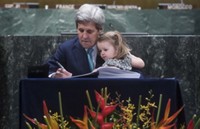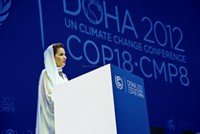Advertisement
Grab your lab coat. Let's get started
Welcome!
Welcome!
Create an account below to get 6 C&EN articles per month, receive newsletters and more - all free.
It seems this is your first time logging in online. Please enter the following information to continue.
As an ACS member you automatically get access to this site. All we need is few more details to create your reading experience.
Not you? Sign in with a different account.
Not you? Sign in with a different account.
ERROR 1
ERROR 1
ERROR 2
ERROR 2
ERROR 2
ERROR 2
ERROR 2
Password and Confirm password must match.
If you have an ACS member number, please enter it here so we can link this account to your membership. (optional)
ERROR 2
ACS values your privacy. By submitting your information, you are gaining access to C&EN and subscribing to our weekly newsletter. We use the information you provide to make your reading experience better, and we will never sell your data to third party members.
Environment
Climate Change Conference In Peru Sets Stage For Global Emission Control Commitments In 2015
Negotiators plan to finish new agreement next year
by Cheryl Hogue
December 1, 2014
| A version of this story appeared in
Volume 92, Issue 48
As a two-week conference starts today in Lima, Peru, governments from around the world are gearing up for a year’s worth of intense talks on climate change. Negotiators are striving to finish a new United Nations climate change agreement—one that will include commitments by both industrialized and developing countries—by the end of 2015. Their goal is to minimize human-caused global warming by cranking down worldwide emissions of carbon dioxide and other greenhouse gases.
With the world’s economy largely running on fossil fuels, negotiators have a major challenge on their plates. Yet they’re not trying to complete this elephantine task in a single bite. Instead, they are trying to make a significant dent in the global growth of greenhouse gas emissions. If countries are to meet the internationally agreed-upon goal of holding global average temperatures to 2 °C above preindustrial levels by 2100, they will have to forge yet another deal, or deals, in coming decades to lower emissions further.
As a step toward that goal, the Lima meeting is expected to produce “a rough first cut” of the 2015 pact, says Elliot Diringer, executive vice president of the Center for Climate & Energy Solutions, a nonpartisan group that advocates for action to combat climate change. Starting early next year, negotiators will refine the product of the Lima gathering and circulate a close-to-final draft agreement in May. They are expected to seal the deal next December at a conference in Paris.
The planned agreement is significantly different from the 1997 Kyoto protocol, the world’s most recent climate treaty. That accord, which has for virtually all practical purposes expired, imposes targets and timetables on industrialized countries—but not developing ones—for cutting greenhouse gas emissions. The U.S., historically the world’s largest emitter of these gases, rejected the Kyoto protocol.
In contrast, the planned Paris pact is taking into account how the world has changed since the Kyoto deal was cut. Foremost, the new agreement is expected to require every UN country to control its own greenhouse gas emissions. Although this would translate into emissions reductions for the U.S., European Union, and other long-industrialized nations, it likely means emissions from many developing countries and emerging economies such as China will increase for a number of years before declining.
In another difference from the Kyoto protocol, negotiators of the Paris accord won’t have to reach an international consensus on binding emission targets and deadlines for countries, Diringer points out. They’re using a new approach, asking each nation to put forward an emissions control plan that would apply only to itself. Those proposals, due in March, will be incorporated into the new agreement. China and the U.S., the world’s first and second-largest emitters of greenhouse gases, drummed up international political momentum for the approach last month when they jointly announced their intended proposals (C&EN, Nov. 17, page 7).
Negotiators have yet to settle whether the Paris deal will be legally binding like the Kyoto protocol or a more informal agreement, says Jennifer Morgan, global director of the climate program at the World Resources Institute, an environmental think tank. They are likely to wait until next year to decide, she says.
But whatever shape those commitments take, Morgan continues, money will be critical to success of the talks. Many developing countries have indicated they will only sign up for the new agreement if other nations contribute to the Green Climate Fund. That international organization assists developing countries in adopting lower-carbon energy sources and energy-efficient technology and adapting to climate change.
In November, several countries, including Mexico and South Korea, pledged a total of $9.3 billion to the Green Climate Fund. That figure includes $3 billion pledged by President Barack Obama. But because Congress holds the federal purse strings, chances are dim that its Republican leaders, many of whom are skeptical about human-caused climate change, will appropriate dollars for the fund.
Money aside, a recent analysis from the UN Environment Programme says the world faces a significant gap between current emission trends and what is needed to limit global temperature rise to 2 °C. To achieve this goal, the analysis says, the world will need to reach a point called carbon neutrality, at which emissions equal offsets—such as carbon dioxide uptake by forests or carbon capture and sequestration—between 2055 and 2070.






Join the conversation
Contact the reporter
Submit a Letter to the Editor for publication
Engage with us on Twitter